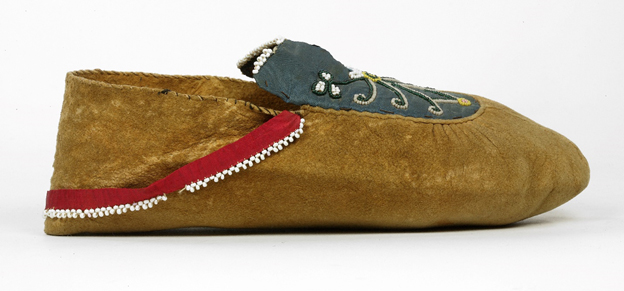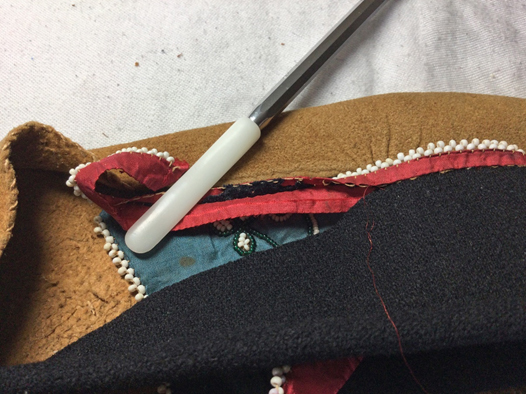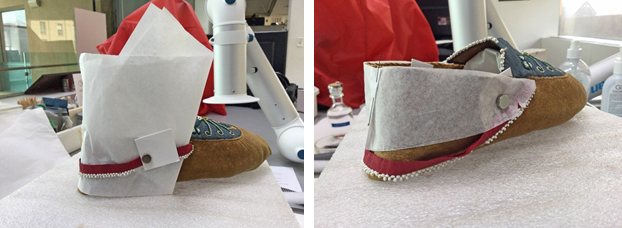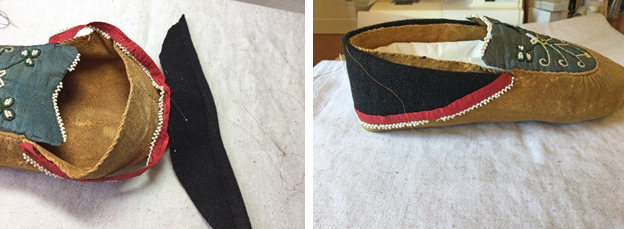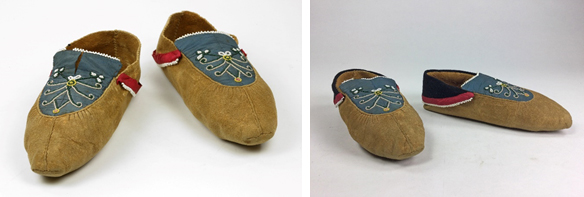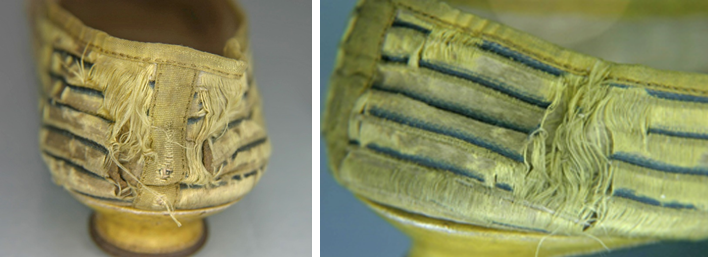A previous conservation blog (April 18, 2021) discussed cleaning beadwork and infilling holes in the textile components on a pair of Tlingit moccasins. These Innu moccasins are also part of the next loan to the National Gallery of Canada (NGC). The damage on this particular pair was more significant: both collars were missing. Replacing them required permission to proceed with the treatment. With this in mind, I contacted Alexandra Kahsenniio-Nahwegahbow, the exhibition’s curator at the NGC and proposed replacing the collars on both moccasins to which she agreed.
Originally, the red silk ribbon, with the white pekoe beadwork trim that drapes over the quarters, would have been attached to a fabric collar. The ribbon is folded in half; one side would have been sewn to the underside of the collar, the outward facing side of the ribbon would have been sewn to the front of the fabric. Examining similar Innu moccasins in the BSM collection and the Canadian Museum of History’s online collection indicated how the collar was attached to the deerskin topline edge.
Remnants of the original wool collar were found within the folds of the ribbon. The jagged outline of the pieces is indicative of a previous moth infestation. Finding these pieces was so helpful as it informed the original fibre content of the fabric (wool), its weight and colour. A similar wool fabric was sourced at a local Toronto store specializing in woolen suit material.
Fabric is always washed, prior to conservation, to remove any surface treatments applied by the manufacturer to facilitate premarket handling and shipping. A pattern for the new collars was created with tissue paper held onto the quarters on one of the moccasins with rare earth magnets. A pleat at the centre back was necessary to achieve the required shape as it wrapped around the heel area. This template was used to cut the new wool collars, plus the addition of 1cm for the hem at the top edge.
The hem was folded over and stitched in place. This would create a clean edge along the topline as it shows several millimeters above. The centre of the underside of the collar was matched to the centre of the underside of the ribbon, then stitched together working from that point towards the point of attachment on either side of the apron using a fine beading needle and hair silk dyed to match the ribbon. Then the right side of the ribbon was sewn to the right side of the collar using the same technique. The final step was to attach the collar to the moccasin using a beading needle that slipped easily underneath the existing stitches.
The plan is to install the loan sometime in June, although currently museums are closed in the province of Ontario. Hopefully, when pandemic travel restrictions are lifted, you will be able to visit Ottawa and see this exhibition in the Indigenous and Canadian Galleries when the National Gallery of Canada reopens to the public.
Before and after photos; the tear in the centre of the apron – left moccasin in first photo – has also been repaired.
Ada Hopkins, Conservator



